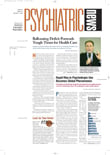An experimental intervention of cognitive-behavioral therapy appears to be effective in preventing major depressive disorder among patients in a primary care setting who have depressive symptoms but do not meet DSM-IV criteria for major depression.
Small but significant effects on depressive symptoms and on health-related quality of life were also found, according to a report in the November British Journal of Psychiatry.
“Depression is one of the most important causes of disability and is expected to be the second-leading cause of disability worldwide in 2020,” wrote Godelief Willemse, Ph.D., and colleagues at the Netherlands Institute of Mental Health and Addiction.
“Reducing the burden of depression is possible.... Perhaps of equal importance is the opportunity to offer a simple self-help treatment, which can be effective while consuming only small amounts of health care resources. The further development and research of preventive interventions in this area constitute a major challenge for prevention science.”
The 216 subjects were recruited from 19 general practices in the Netherlands; 107 were randomly assigned to “minimal-contact psychotherapy,” and 109 were assigned to usual care in the primary care setting.
All were screened for subthreshold depression. Subthreshold depression was defined as having at least one core symptom and one to three current depressive symptoms as measured by the Instel screening instrument but not meeting the DSM-IV criteria for full-blown depressive disorder. The Instel instrument was developed by researchers in the Netherlands for use by general practitioners in detecting depression.
The experimental intervention involved use of cognitive-behavioral therapy for depression, based on the Dutch-language version of Lewinsohn's“ Coping With Depression” course. The main component is a self-help manual with instructions on cognitive-behavioral mood-management skills that can be used by the depressed individual with minimal outside assistance.
The intervention was augmented by a face-to-face interview with a prevention specialist or a clinician from a community mental health center before the participant began reading the manual, and six short phone calls to support the participant in working through the manual.
Subjects receiving the intervention were able to make use of all other types of health services during the study period, including those offered by their general practitioner. The control intervention was usual care as routinely provided by general practitioners and other health service providers.
One year after baseline, the incidence of major depressive disorder was found to be significantly lower in the intervention group (12 percent) than in the group receiving usual care (18 percent).
Using two measurement scales—the Center for Epidemiological Studies Depression scale (CES-D) and the RAND-36 Health Item Survey—small but significant effects were also found on depressive symptoms and health-related quality of life. Participants receiving the intervention showed significant improvement on the CES-D and on two measures of the RAND-36 scale:“ physical functioning” and “mental health.”
The authors suggested that the intervention might be made even more effective by targeting it to specific at-risk groups, and they referenced a study appearing in the December 2001 Archives of General Psychiatry that looked at the effects of using a group cognitive intervention for adolescent children of depressed parents. In that study, the incidence of depression dropped from 29 percent to 9 percent.
“Another possibility for selection is to offer the intervention on a stepped-care [basis] by starting with a short waiting time to exclude patients who recover quickly, because `watchful waiting' in itself can be an effective strategy,” they wrote.
The study was supported by the Health-care Research Council of the Netherlands.
Br J Psychiatry 2004 185 416
